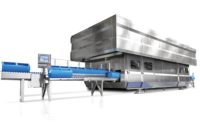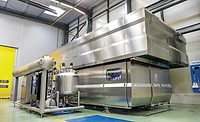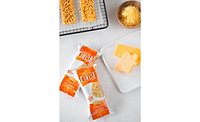Novel no more: HPP grows with batch processing, new bulk juice handling
High pressure processing will continue to expand with increasing consumer demand for natural, fresh-tasting foods without preservatives

The Avure AV-X is the world’s first expandable HPP machine that can upgrade from AV-40X to AV-70X.
Photo courtesy JBT Avure
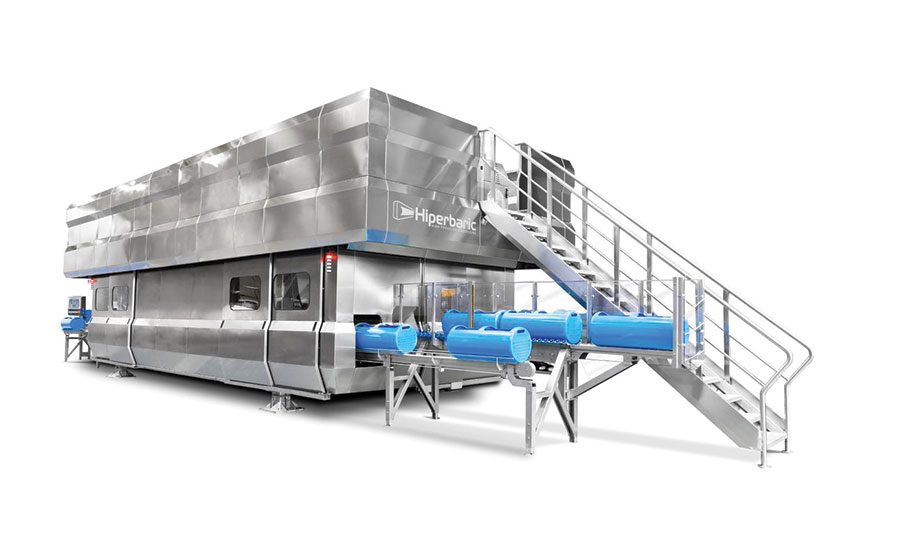
With a 525-liter capacity and 380 mm diameter, the Hiperbaric 525 has throughputs of more than 3,000 kg of product per hour.
Photo courtesy Hiperbaric

To maintain the nutrients, taste quality and color of Lumen’s hemp shots, the company uses HPP Food Services, a toller in southern California, to package its products.
Photo courtesy Lumen
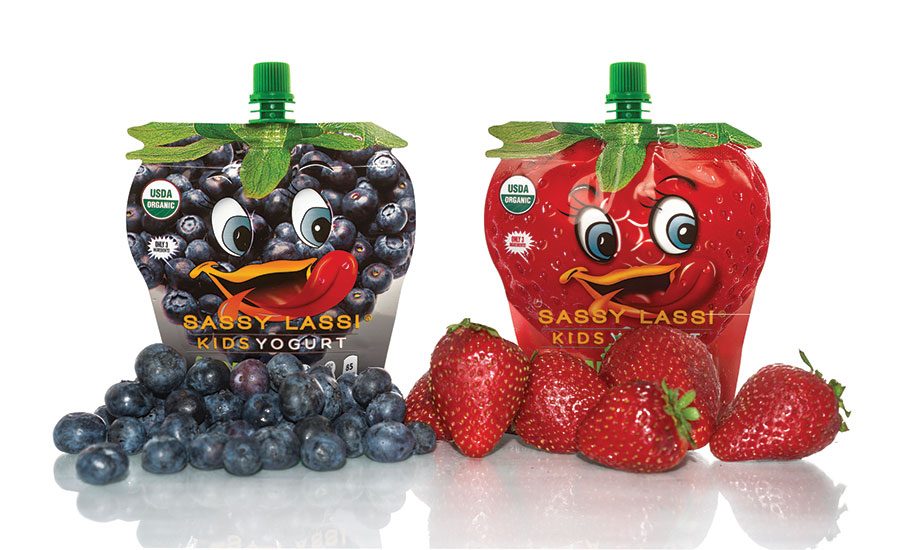
Sassy Lassi uses Texas Food Solutions’ tolling service for its kids yogurt drinks.
Photo courtesy Sassy Lassi




HPP is no longer a novelty.
The worldwide market for HPP equipment is expected to grow at a CAGR of roughly 11.7% over the next five years and will reach $850 million in 2024, up from $490 million in 2019, according to an industry report titled, “Global High-Pressure Processing Equipment Market 2019 by Manufacturers, Regions, Type and Application, Forecast to 2024.”
This data appears to be on point. “More and more companies are choosing HPP to produce fresh, preservative-free foods and beverages, with better taste and nutrition,” says Roberto Peregrina, chief scientific technologist at Hiperbaric, an HPP equipment manufacturer. “For processors, HPP provides the added benefit of extending shelf life two to 10 times that of other pasteurization methods. With increasing consumer demand for natural, fresh-tasting foods with no preservatives, HPP will continue to grow and new applications will be added.”

Hiperbaric, which developed bulk HPP processing for liquids, expects growth in alcoholic beverages and infused drinks, such as cold brew coffee.
–Roberto Peregrina, chief scientific technologist, Hiperbaric
Lisa Wessels, CMO at JBT Avure, another leading HPP equipment manufacturer, says that processors are moving in a few directions with the types of foods and beverages they are using HPP to make.
“At the beginning of the HPP journey, it was mostly salsa and guacamole, but now we see more hummus, plant-based dips and even alcohol mixers.” Ready-made meals, pet food and baby food also are being packaged using HPP, she says.
The growth in the range of HPP products is only going to continue, Peregrina says. “HPP equipment can be used in a wide range of products, including juices and beverages, avocado products such as guacamole, deli meats, seafood, ready-to-eat meals, dips, spreads, salsas, wet salads, sandwich fillings, baby food, dairy and pet food. Companies like Good Foods, Hormel, Applegate, Suja and Evolution Fresh are using HPP to keep their products safe, while preserving taste and nutrition.”
As HPP continues to grow, it offers a number of opportunities—and challenges—for processors who are looking to adopt it.

For processors that want to try HPP, starting with a toller is less expensive. As business grows, reassess whether to buy a machine and use the toller as a backup.
–Lisa Wessels, CMO, JBT Avure
Keep it cool
Peregrina explains that HPP is referred to by some as “cold pasteurization,” because the technology meets or exceeds food safety standards achieved by heat pasteurization. “Unlike thermal processing, HPP uses cold water (4-25 °C; 40-75°F) at high pressure (up to 6,000 bar or 87,000 psi) to eliminate foodborne pathogens like Listeria and E. coli, and extend shelf life of refrigerated foods with minimal effects on nutritional or sensory properties,” he says.
This is critical in products that market their nutritional benefits. Take Lumen hemp juice shots, for example. Co-founded by Kristofer Taylor (COO), Yasir Hashim (CEO) and Jacob Freepons, Lumen hemp shots are reported to be the only organic whole leaf hemp wellness shot in the U.S. The company’s endeavor began in 2017, and it took about 18 months of R&D before they were ready to launch. Entering the market using Indiegogo crowdfunding, it sold about $35,000 worth of product over six weeks in early 2019 and then officially launched into the retail market in March that same year.
Lumen grows its hemp in Oregon using organic regenerative agriculture.
“This is farming that heals the planet at the same time we farm it,” Taylor explains. “We harvest the hemp fresh off the field and within 24 hours it’s ready for freezing.”
The harvested hemp is washed, ground and juiced using a proprietary cold-pressed method that allows Lumen to get the most out of the plant. “We flash freeze it to maintain nutritional quality, and then immediately ship it to California where it’s made into hemp shots or sold as an ingredient. We describe ourselves as an ingredient manufacturer for ourselves,” Taylor says.
To maintain the juice’s integrity and nutrients as well as overall taste, quality and color, Lumen uses True Fresh HPP, a toller in southern California recently acquired by HPP Food Services, to package its products. “They are a great partner for us,” Taylor says.
When asked why they chose to use HPP, Taylor says it was the only logical solution. Because the hemp juice is cold-pressed and uses the whole leaf, not just isolated parts of it, it is very nutrient-dense, Taylor says. The team knew that heat pasteurization would not be a fit in this case.
“With our science background (Taylor and Hashim attended medical school but exited to co-found Lumen), we looked at the whole aspect of the 5-log reduction from a very analytical point of view. What did we want our product to be like? What affect did we want the process to have on our product?” He says the only other cold step alternative was UV pasteurization, “but you really have to dilute the product down to the point of clarity so you can’t really have a very nutrient-dense product; therefore, that was out of the question for us,” he says.
Jasmine Sutherland, president of Texas Food Solutions, a toller in Houston, says, “Traditional pasteurization is great, but it utilizes heat, which changes flavor and compromises nutritional value.”
Jaya Shrivastava, founder and CEO of Sassy Lassi, a Texas Food Solutions’ customer, says her company utilizes the high-pressure process on its kids yogurt drinks, which are made with just three organic ingredients: cultured, Grade A whole milk; organic fruit juice; and organic cane sugar. “We use HPP to keep Sassy Lassi safe to consume while maintaining the fresh flavor and the full nutritional power of our organic ingredients,” she says.
Sutherland says that HPP gives her customers peace of mind and their product a longer life.
“They know they have an insurance policy that the product is pathogen-free and can be clean label, while also gaining shelf life to manage logistics, economize their production schedules and give the customer a much longer shelf life than with a traditionally processed product,” she says.
Talking trends
HPP began as a manual batch process, and it has progressed over the years. Hiperbaric’s Peregrina says the company foresees that progression continuing as the technology is adopted in multiple food sectors around the world.
“Parents all around the world keep looking for healthy fruit and vegetable purees for infant feeding, a category that has notably diversified in the last years,” he says. “HPP makes it possible to distribute fresh avocado products to meet growing consumer demands. Similarly, hummus and other plant-based dips have followed the path paved by avocado, and their popularity just keeps increasing.”
For the meat sector, he says that HPP has proven a reliable intervention to protect pets and pet owners from harmful microorganisms potentially present in raw meat diets. “Pet food companies continue to adopt HPP, as the technology reduces food waste, extends product distribution and protects against recalls due to enhanced safety and shelf life,” he says.
Other trends with the HPP equipment itself include automating or semi-automating what began as a manual process. JBT Avure’s Wessels points out that the company has developed a dump station mechanism, which allows operators to lift and dump baskets more easily. The company also developed basket dividers and removable ends to help with loading and unloading as well as running different SKUs in the same batch, separating them within the basket to speed up the unpacking.
Kevin Kennedy, North American sales manager at JBT Avure, adds that there are also fully automatic solutions that include the use of robots to facilitate some of the dumping and/or transfer of product. “We are working with some outside partners to help find solutions to help reduce labor on the front and back ends of the HPP equipment, helping to facilitate the integration of robots with our customers. The Internet of Things and data management are trending as well,” he says. JBT Avure has a program called iOPS Gateway, which provides companies data to evaluate and understand trends and process weaknesses.

Some HPP setups are fully automatic, using robots for some of the dumping and transfer of products.
–Kevin Kennedy, North American sales manager, JBT Avure
Peregrina says Hiperbaric is seeing more beverages, such as premium juices, flavored waters and wellness shots. He expects to see growth in alcoholic beverages and infused drinks, such as cold brew coffee and tea. Hiperbaric has developed in-bulk HPP for juice and beverage processing. This is perhaps the biggest advancement in HPP technology yet.
“In the traditional in-pack HPP process, beverages are placed in baskets in their final packaging, carried into a high-pressure chamber, and then pressurized to inactivate bacteria, viruses, molds and parasites,” he says. “However, by processing liquids in bulk, twice as much product per batch can be handled, and then bottled in any format, from cans to glass bottles.”

In the in-bulk process, beverages are transferred into a large (500L) recyclable plastic pouch, occupying 90% of the total high vessel volume (vs. 45-55% for in-pack HPP), which lasts about 100 cycles. High-pressure pumps inject 15% extra water volume to surround the multicycle pouch with the beverage, and this raises pressure up to 6,000 bar (87,000 psi), he explains. The unit holds pressure for a few minutes and releases pressure as in conventional HPP equipment. After that, the beverage is unloaded into an ultraclean extended shelf life (ESL) tank and goes to an ESL filling line, where it can be bottled in any type of packaging material, including options, such as a glass bottles and metal cans, not available for conventional HPP units.
“Since there is no manual handling of bottles or packaging, labor costs are reduced by more than 80%,” he says. “The energy cost per liter of an HPP beverage is also cut by 50%, as almost twice the volume of juice is processed per cycle, while replacement parts costs per liter are reduced by more than 30%. So in total, the cost/L is reduced by at least 40%.”
Tackling the challenges
No technology is without challenges, and HPP is no exception. Peregrina says the biggest challenge of a food technology such as HPP is the cost of the final product, which is affected by the ratio of investment cost versus productivity, as well as production line automation. Safety and reliability of machines, as well as after-sales service, also impact the cost, he says. “On one hand, high-pressure parts have a short lifespan if they are not well designed and built. One the other hand, about half of the users of HPP have only one machine, so they cannot afford downtimes.”
The cost of HPP needs to be balanced with its benefits of producing safe foods with healthy ingredients and a longer shelf life, he says. “Another challenge is packaging, since most products need to use plastic and that limits materials. In-bulk HPP solves that issue as any type of packaging can be used, including bottles or cans.”
Bulk HPP is for larger quantities of product, of course, because of the way the machine is developed and costs. Peregrina says companies that produce large quantities of juice, for instance, would be good candidates for the Hiperbaric bulk machine—as is the case for the French juice manufacturer Ateliers Hermes Boissons, the first to adopt Hiperbaric’s newest technology.
To address the issue of cost, Wessels says it is less expensive to start with a toller and then look at the business based on volume and growth trends. “Does it make sense for me to stay with a toller as my primary source, or use them as a backup or in conjunction with my own machine?”
“Another challenge that is application-specific is packaging (for batch processing),” Kennedy says. “A lot of packaging does work with HPP but some works better than others. So if a customer wants to push the limits with a package, sometimes that can be a challenge. We work with a lot of the global packaging suppliers and they have become really understanding of what works for HPP in most cases.”
For more information:
Hiperbaric, www.hiperbaric.com
JBT Avure, www.jbtc.com
Lumen, www.drinklumen.com
Sassy Lassi, www.sassylassi.com
Texas Food Solutions, www.texasfoodsolutions.com
True Fresh HPP http://truefreshhpp.com
Looking for a reprint of this article?
From high-res PDFs to custom plaques, order your copy today!




